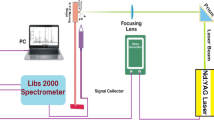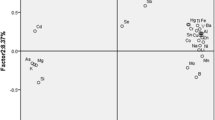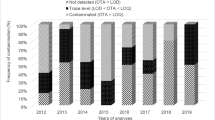Abstract
Contamination of toxins in chicken’s liver is a serious concern for human health owing to related threats of cytotoxicity and general pathologies after their digestion. The quantitative investigations were accomplished by calibration curves plotted for all the detected toxins via typical samples arranged in the known concentrations in the chicken liver’s matrix. The chicken liver samples were collected from the Khyber Pakhtunkhwa province of Pakistan and found to contain heavy metals like Cu, Mn, Ni, Pb, and Zn. The analytical estimations were performed under the suppositions of local thermodynamic equilibrium (LTE) in terms of optical thin plasma. The maximum concentrations (parts per million) of Cu, Mn, Ni, Pb, and Zn were as 2.87 ± 0.02 ppm, 7.80 ± 0.13 ppm, 2.84 ± 0.02 ppm, 4.00 ± 0.08, and 83.5 ± 2.10 ppm respectively. Abundance of Cu, and Pb was found considerably beyond the maximum accepted boundary of WHO. Likewise, the level of Ni exceeded the permitted bounds of WHO in samples 01 and 02. To validate our laser-induced breakdown spectroscopy investigation, we approximated the abundance of identical (duplicate) chicken livers through digesting the specimens in suitable solvents by a typical technique such as inductively coupled plasma/optical emission spectrometry (ICP/OES) and the results acquired were in outstanding harmony. Furthermore, the existence of detected toxins was also checked using energy dispersive X-ray spectroscopy (EDX). It is worth stating that larger amounts of Cu, Ni, and Pb in poultry may cause a severe hazard to customers which required security actions and precautions. Our findings are extremely important to make an awareness among the people due to associated health hazards after the digestion of toxins through chicken liver and to protect numerous human lives.









Similar content being viewed by others
References
Almazroo OA, Miah MK, Venkataramanan R (2017) Drug metabolism in the liver. Clin Liver Dis 21(1):1–20
RC Gupta (2012) Veterinary toxicology: basic and clinical principles. kantucky, USA
Wang S, Shi X (2001) Molecular mechanisms of metal toxicity and carcinogenesis. Mol Cell Biochem 222(1):3–9
Manikandan E et al (2011) 2 MeV-PIXE technique for coastal material analysis. Int J PIXE 21(03n04):75–86
Elayaperumal M et al (2021) Ion beam analysis of proton-induced X-ray emission (PIXE) techniques for elemental investigation of young stage neem leaf of southern India. Tamil Nadu Biol Trace Elem Res 199(9):3540–3546
PRITHIVIRAJ B et al (2011) Elemental accumulation patterns of the lichen species Physcia tribacoides nyl., Heterodermia dissecta and Bacidia beckhausii Körber from the Walayar Rf Region, Tamil Nadu, India. Int J PIXE. 21(03n04):133–144
Draper DE, Grilley D, Soto AM (2005) Ions and RNA folding. Annu Rev Biophys Biomol Struct 34:221–243
Denesyuk NA, Thirumalai D (2015) How do metal ions direct ribozyme folding? Nat chem 7(10):793–801
Kennelly P (2018) The biochemical roles of transition metals. Harper’s Illustrated Biochemistry 31st edn., McGraw-Hill, New York
Jaishankar M et al (2015) Toxicity, mechanism and health effects of some heavy metals. Interdiscip Toxicol 7(2):60–72
Wu X et al (2016) A review of toxicity and mechanisms of individual and mixtures of heavy metals in the environment. Environ Sci Pollut Res 23(9):8244–8259
Rehan I et al (2021) Nutritional and toxic elemental analysis of dry fruits using laser induced breakdown spectroscopy (LIBS) and inductively coupled plasma atomic emission spectrometry (ICP-AES). Saudi J Biol Sci 28(1):408–416
Al-Zuhairi WS, Farhan MA, Ahemd MA (2015) Determine of heavy metals in the heart, kidney and meat of beef, mutton and chicken from Baquba and Howaydir market in Baquba, Diyala Province, Iraq. Int J Recent Sci Res 6(8):5965–5967
Yayayürük O, Yayayürük AE (2017) Determination of mercury, lead, cadmium, copper, iron and manganese in sheep, cow and chicken liver samples in turkey. Gıda 42(5):546–552
Rehan I et al (2018) Application of laser induced breakdown in air in conjunction with atomic absorption spectroscopy for detection of trace elements in fennel seeds. Opt Spectrosc 125(1):130–136
Telle HH, Beddows DCS, Morris GW, Samek O (2001) Sensitive and selective spectrochemical analysis of metallic samples: the combination of laser-induced breakdown spectroscopy and laser-induced fluorescence spectroscopy. Spectrochim Acta B 56(6):947–960
Gondal MA, Hussain T, Yamani Z (2008) Optimization of the LIBS parameters for detection of trace metals in petroleum products. Energy Sources A: Recovery Util. Environ Eff 30(5):441–451
Rehan I, Gondal MA, Sultana S, Dastageer MA, Aldakheel RK, Almessiere MA, Muhammad R, Rehan K (2021) Elemental compositions of earthquake-stricken soil from the vicinity of the epicenter at Eurasian and Indian tectonic plates using calibration free laser induced breakdown spectroscopy. Arab J Sci Eng 46(6):6101–6108
Motaung DE et al (2010) In situ optical emission study on the role of C2 in the synthesis of single-walled carbon nanotubes. J Appl Phys 107(4):044308
Rehan I et al (2019) Quantitative analysis of Fuller’s earth using laser-induced breakdown spectroscopy and inductively coupled plasma/optical emission spectroscopy. Appl optics 58(16):4227–4233
Rehan I, et al. (2021) Determination of nutritional and toxic metals in black tea leaves using calibration free LIBS and ICP: AES technique. Arab J Sci Eng 1–9.
Baykov BD, Stoyanov MP, Gugova ML (1996) Cadmium and lead bioaccumulation in male chickens for high food concentrations. Toxicol Environ Chem 54(1–4):155–159
Organization WH (1996)Trace elements in human nutrition and health: World Health Organization, Geneva
Ma Clark I, Fox MK (2009) Nutritional quality of the diets of US public school children and the role of the school meal programs. J Am Diet Assoc 109(2):S44–S56
Authority, A.N.Z.F., (2001) Phomopsins in Food: A Toxicological Review and Risk Assessment: Australian New Zealand Food Authority.
Ali HS, Almashhadany DA, Khalid HS (2020) Determination of heavy metals and selenium content in chicken liver at Erbil city, Iraq. Italian Journal of Food Safety 9(3):1–6
Author information
Authors and Affiliations
Corresponding authors
Ethics declarations
Competing Interests
The authors declare no competing interests.
Additional information
Publisher's Note
Springer Nature remains neutral with regard to jurisdictional claims in published maps and institutional affiliations.
Rights and permissions
About this article
Cite this article
Rehan, I., Sultana, S., Rehan, K. et al. Estimation and Quantification of Toxic Metals in Hugely Consumed Chicken Livers by Advanced Diagnostic Approaches. Biol Trace Elem Res 201, 377–386 (2023). https://doi.org/10.1007/s12011-022-03147-0
Received:
Accepted:
Published:
Issue Date:
DOI: https://doi.org/10.1007/s12011-022-03147-0




